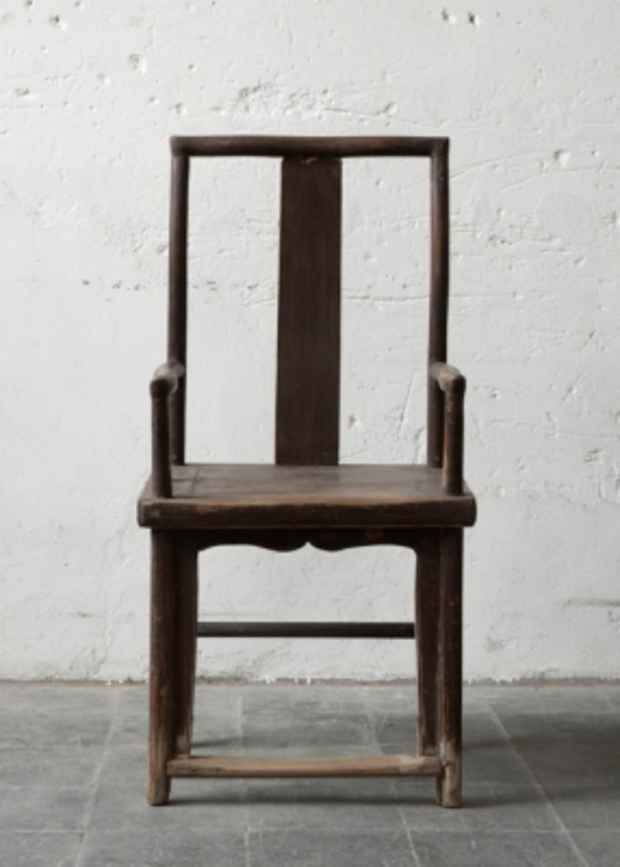Ai Weiwei "Fairytale Chairs and New York Photographs"
Carolina Nitsch Project Room

This event has ended.
Carolina Nitsch presents the exhibition Ai Weiwei: Fairytale Chairs and New York Photographs. This show includes a selection of the 1001 Qing Dynasty chairs from Ai’s Documenta XII project as well a deluxe portfolio of his photographs from 1983-1993.
Ai Weiwei’s venture, titled Fairytale, for Documenta XII (2007) in Kassel, Germany was comprised of 3 separate but related projects. One element was the installation of 1001 Qing Dynasty (1644-1911) chairs that would become ‘stations of reflection’ in and around the city, available to all for the duration. This traditional yoke-back style chair is personally significant to the artist as it connects to his childhood memories of his family’s exile in China’s remote northern areas. His father, Ai Qing, a prominent poet, fell out of favor with the communist party during the Anti-Rightest Movement of the 1950’s and 60’s. One of the objects his family was allowed to keep was a Qing Dynasty chair.
The second element of Faiytale was a structure called Template, made from 1001 Ming and Qing Dynasty (1368-1911) wooden windows and doors, which formerly belonged to destroyed houses across China. They were joined together to create a vertical structure with an eight-pointed base and forming, in the center, the negative space of a traditional Chinese temple. By appropriating the chairs, windows and doors they become a symbol of both continuity and changing traditions.
The last element was to arrange for the visit of 1001 Chinese citizens to the little town of Kassel (population 194,796), which is also the native town of the brothers Grimm. This project changed the lives of the Chinese visitors by providing them with new social, political, and cultural experiences and was achieved through an immensely complex effort of planning and organization, covering everything from the participants’ passport and travel arrangements to the design of their luggage and living quarters. Ai Weiwei has said, “I see the whole process as the work itself. I see what kind of hopes, what kind of worries, what kind of frustrations… and waiting, and anticipating… then the dream, then imagination, then… maybe surprise”. When asked about the significance of the number 1001, the artist explained: “The number 1001 is one person more than one thousand. The significance is to try to emphasize individuals rather than groups. To me it would suggest and relate to collected individuals rather than a group. It represents individual consciousness and awareness.”
The other part of our exhibition comprises photographs by Ai Weiwei taken while living in New York’s Lower East Side from 1983-1993. He got to know Allen Ginsberg and welcomed numerous visitors from China to his East 3rd Street apartment, many of whom such as Tan Dun and Liu Xiaodong have since become widely known. Towards the end of the 1980s as the neighborhood became increasingly gentrified, demonstrations and street violence became commonplace, particularly around Tompkins Square Park. Ai Weiwei’s photographs document his own development as an artist and public figure as well as the transformation of the East Village from a desolate scene of urban blight into a desirable residential neighborhood.
Now that Ai Weiwei is widely recognized not only as an artist but also as a major cultural and political figure, deeper layers of meaning will undoubtedly become evident as admirers of his work absorb the significant amount of new information contained in this visual autobiography. The photographs selected are all self-portraits, revealing many different aspects of his personality and offering clues into the development of his artistic practice and thinking.
[Image: Ai Weiwei "FAIRYTALE CHAIR (G-64)" (2007) 1 Qing dynasty wooden chair (1644 - 1911), 42 ⅞ x 19 ¾ x 15 ⅜ in.]
Media
Schedule
from September 07, 2012 to November 03, 2012